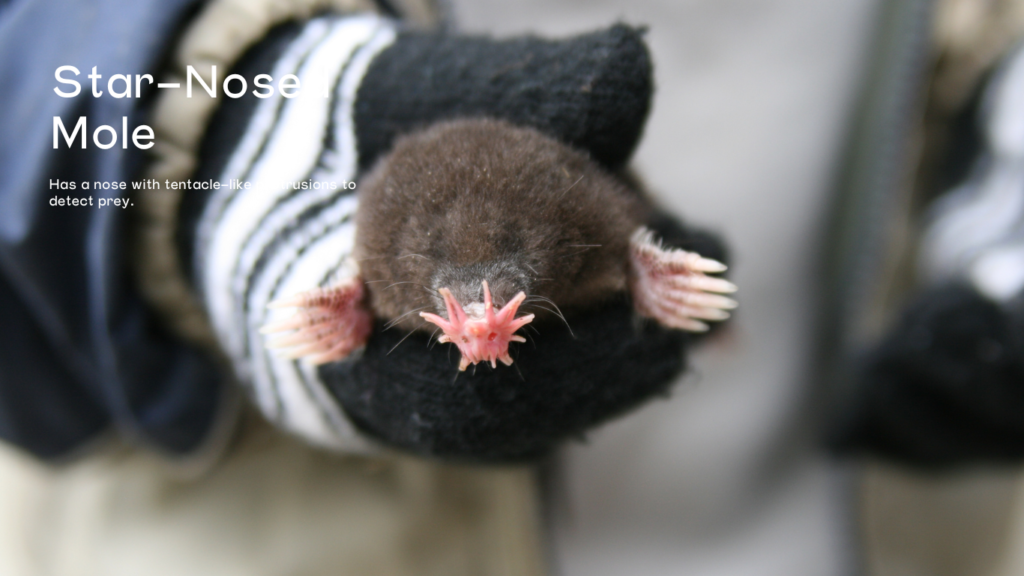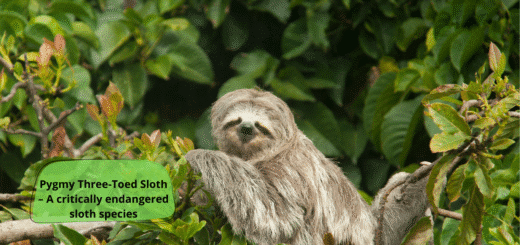The Fascinating World of the Star-Nosed Mole: Nature’s Unique Marvel
The star-nosed mole (Condylura cristata) is a small mammal that has captivated scientists and nature enthusiasts alike due to its unusual appearance and exceptional sensory capabilities. Found in wetlands and marshes of North America, particularly in eastern Canada and northeastern United States, the star-nosed mole stands out for its peculiar, star-shaped nose. This article explores the anatomy, habitat, diet, and extraordinary sensory abilities of the star-nosed mole, revealing why this tiny creature is one of the most unique and efficient hunters in the animal kingdom.

Anatomy and Unique Features
The star-nosed mole is a small mammal, typically measuring about 15 to 20 centimeters (6-8 inches) in length and weighing roughly 55 grams (2 ounces). Its most distinctive feature is, of course, its “star”—a ring of 22 fleshy, pink tentacle-like appendages, each about a millimeter in length, arranged around its nose. This star-shaped nose contains more than 25,000 Eimer’s organs, which are specialized touch receptors. These organs make the star-nosed mole’s nose one of the most sensitive tactile organs in the animal kingdom, allowing it to detect even the slightest of textures and vibrations in its environment.
Unlike most other moles, the star-nosed mole has relatively large front claws and webbed feet, which serve two primary purposes: digging through the soil and swimming through water. The mole’s fur is dense and water-repellent, allowing it to move through wet and muddy environments with ease. Additionally, its long, hairless tail, which becomes fatter in the winter as it stores up fat for energy, acts as a stabilizer and also aids in its movement through water.
Habitat and Distribution
The star-nosed mole is native to North America, predominantly found in the wetlands of eastern Canada and northeastern United States. Unlike other moles that prefer dry, forested areas, the star-nosed mole is uniquely adapted to a semi-aquatic lifestyle, often living in marshes, swamps, and the banks of rivers and streams. It thrives in areas with soft, moist soil that are abundant with invertebrates, its primary food source.
Moles live in burrows that they dig with their powerful front claws. The star-nosed mole, however, has a slightly different system: its burrows often open directly into the water, allowing it to easily enter or exit the water as it hunts. The mole’s habitat reflects its preference for moisture-rich environments where it can use both land and water to forage for food.
Diet and Feeding Habits
The diet of the star-nosed mole primarily consists of small invertebrates, such as worms, insects, and crustaceans. It also consumes small amphibians and fish when available. However, its preferred food source is aquatic invertebrates, such as aquatic worms and mollusks, which it detects and captures with remarkable efficiency.
The star-nosed mole is known to be one of the fastest eaters in the animal kingdom. Studies have shown that it can identify and consume prey in as little as 120 milliseconds—faster than the blink of an eye. This rapid feeding is facilitated by the incredible sensitivity of its star-shaped nose, which it uses to locate and identify potential food sources almost instantaneously.
The feeding process of the star-nosed mole is a marvel in itself. Its brain is wired to process tactile information from its nose’s appendages at an extremely rapid rate, enabling it to recognize prey almost instantly. Each of the 22 appendages on the mole’s nose moves independently, quickly analyzing the texture, size, and shape of objects in the mole’s path. This high-speed processing allows the mole to make split-second decisions while hunting, a necessity in its competitive environment where food sources can be scarce.
Extraordinary Sensory Abilities
The star-nosed mole’s most remarkable characteristic is its sense of touch, provided by the Eimer’s organs in its star-like nose. These sensory receptors are highly specialized for detecting minute textures and vibrations in the environment, making the star-nosed mole one of the most touch-sensitive animals known to science. Each of the 22 appendages is packed with sensory cells, enabling the mole to detect minute differences in texture, temperature, and movement.
These touch receptors allow the mole to navigate its often dark, murky environment, quickly distinguishing between edible and inedible items. In water, the mole uses its nose to feel for vibrations from potential prey, functioning in a way similar to echolocation used by bats or sonar used by dolphins. Though it lacks the auditory component of these systems, its star-nosed “radar” can detect prey that would be nearly invisible to other animals.
Adaptations to a Semi-Aquatic Lifestyle
One of the few mole species adapted to a semi-aquatic lifestyle, the star-nosed mole is an excellent swimmer and frequently forages underwater. Its nostrils are capable of closing underwater to prevent water from entering, and its dense, waterproof fur keeps it warm and dry while submerged. Researchers have observed that the mole can hold its breath for up to 15 seconds while swimming, diving, or digging in muddy or aquatic environments, and it uses its front claws and webbed hind feet to propel itself quickly through the water.
In its wetland habitat, the star-nosed mole uses its sensory appendages to locate prey beneath the mud and water, making it a highly effective predator in aquatic ecosystems. This adaptation to life both in and out of water provides the star-nosed mole with a significant advantage, allowing it to exploit a variety of food sources that other moles cannot access.
Reproduction and Life Cycle
Star-nosed moles typically have a short life span, usually around 2 to 3 years in the wild. They breed once a year, usually in early spring, and females give birth to a single litter of 4 to 5 young after a gestation period of about 45 days. Like most moles, star-nosed moles are solitary animals, and males and females only come together during the mating season.
The young are born blind and hairless but develop quickly, opening their eyes after about 2 weeks. By the time they are a month old, they can hunt and dig alongside their parents, and they become fully independent within a few months. By the following year, they are capable of breeding, thus continuing the cycle.
Conservation Status and Ecological Importance
The star-nosed mole is currently classified as a species of “Least Concern” by the International Union for Conservation of Nature (IUCN). However, it is still vulnerable to habitat loss due to human activities, such as wetland drainage, pollution, and urban development. Preservation of wetland ecosystems is essential for the survival of this species, as well as many others that rely on these unique habitats.
Ecologically, the star-nosed mole plays a crucial role in controlling insect populations and contributing to the aeration of soil through its digging. Its predatory habits keep the populations of various invertebrates in balance, and its burrowing helps improve soil quality by mixing organic matter and allowing oxygen to reach deeper layers.
Conclusion
The star-nosed mole is a truly extraordinary creature that has adapted to its environment in fascinating ways. With its specialized star-shaped nose, remarkable tactile sensitivity, and adaptability to both land and water, the star-nosed mole is a testament to the diversity and wonder of the natural world. Though small and often overlooked, this unique mole reminds us of the complexity and ingenuity that evolution can produce. Protecting the star-nosed mole and its habitat is essential to preserving biodiversity, as well as the intricate web of life that depends on species like this to thrive.








